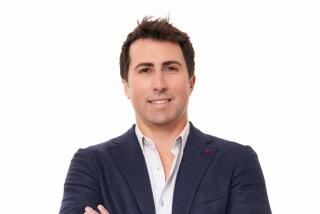Washington Mutual Drops ATM Surcharge
- Share via
Washington Mutual Bank will buck the national trend of charging consumers more fees by dropping a surcharge in California when customers of other banks use its automated teller machines, bank officials said Monday.
At a time banks rely increasingly on fees to boost their bottom lines, California’s third-largest financial institution is abandoning the $1.50-per-transaction charge in a relatively low-cost public relations move it hopes ultimately will attract more customers, bank officials said.
For the record:
12:00 a.m. Oct. 14, 2000 For the Record
Los Angeles Times Saturday October 14, 2000 Home Edition Business Part C Page 3 Financial Desk 1 inches; 36 words Type of Material: Correction
ATM Fees--In a chart in Tuesday’s Business section, the fee listed for non-customers of Wells Fargo & Co. using the bank’s automated teller machines is charged in some states where Wells does business, but not in California. The fee in California is $1.50.
But the thrift is not dropping the fees it charges its own customers to use other banks’ ATMs. And customers of other banks who use any of Washington Mutual’s 1,000 California ATMs starting today still will face charges from their own institutions, most of which charge $1 to $3 when their customers use other banks’ ATMs.
Still, consumer advocates celebrated Washington Mutual’s move.
“That’s a really big deal,” said Janine Benner of the California Public Interest Research Group, which has been protesting the spread of ATM surcharges. “We can credit consumer anger with surcharging for their doing this.”
Analysts, however, said Washington Mutual’s action was unlikely to start a trend.
“I would be very, very surprised if this was the first domino that caused the other majors--Wells Fargo, Bank of America--to follow suit,” said Greg McBride, a financial analyst with Bankrate.com, which tracks banking trends. “It’s the wrong end of the economic cycle and the wrong end of the interest rate cycle for that to make sense.”
Spokeswomen for Bank of America and Wells Fargo confirmed that those banks had no plans to drop surcharges on non-customers.
California Federal Bank, the state’s fourth-largest institution, also plans to keep the surcharge. However, CalFed is planning to waive the fees it charges its own customers who use other banks’ ATMs, as long as the customers have at least $10,000 in accounts with CalFed, spokeswoman Janis Tarter said.
Fee income has become an increasingly important part of bank profits as banks use surcharges and other fees to offset the cyclical nature of their business. Currently, higher interest rates are squeezing banks’ profit margins, forcing them to pay more for deposits while getting less income from interest on fixed-rate loans made when rates were lower, said Gary Findlay, banking analyst with Findlay Co. in Anaheim. Banks also are seeing an increase in bad or delinquent loans, further hurting their profits, analysts said.
Bankrate.com estimates that consumers will pay $2.2 billion in total banking fees this year, compared with $1.58 billion in 1998. The average ATM fee has increased by more than 50% since 1993, according to Bankrate.
Banks’ ability to charge fees received a boost in 1996, when major ATM networks ended their prohibition on surcharges. Surveys show more than 90% of banks nationwide charge non-customers to use their ATMs, while more than 80% charge their own customers who use other banks’ ATMs. In California, about 99% of banks assess surcharges.
Backlash against the fees prompted the cities of Santa Monica and San Francisco to ban the surcharges last year. The state’s two largest banks, Bank of America and Wells Fargo, blocked non-customer access to their ATMs in Santa Monica, where the ban had already taken effect. A federal judge blocked the cities’ bans in November, and the case is on appeal.
Washington Mutual’s surveys of customers and non-customers showed both would favor an institution that did not charge the fees, and the thrift does not expect its move to hurt profits, said Deanna Oppenheimer, head of Washington Mutual’s banking and financial services.
Banks receive fees from ATM networks whenever non-customers use their ATMs, and Washington Mutual will continue to receive those fees, which should offset some of the cost of dropping the surcharge, Oppenheimer said. The thrift also believes the move will position the bank as consumer friendly, which it hopes will attract more customers and further offset the cost, she said. Oppenheimer refused to say how much the bank receives from ATM networks or how much dropping the fees will cost, saying the information was proprietary.
California is one of only two states where Washington Mutual has levied surcharges; the other is Florida. In both cases, the thrift acquired institutions such as Chatsworth-based Great Western Bank and Irvine’s Home Savings Bank that charged the fees. Seattle-based Washington Mutual has never levied surcharges in the Northwest, where the thrift got its start, Oppenheimer said.
Washington Mutual’s reputation for customer service took a hit last year, as merger-related glitches and branch closures irritated some. But while similar problems during Wells Fargo’s 1996 takeover of First Interstate caused an exodus of customers, Washington Mutual’s customer base continued to grow last year and is now over 6 million, Oppenheimer said.
The thrift said it would donate to charity $1.50 for each non-customer that used its ATMs from Oct. 23 to Oct. 30.
(BEGIN TEXT OF INFOBOX / INFOGRAPHIC)
ATM fees
Most banks charge a fee when non-customers use their automated teller machines. ATM users may be charged an additional fee by their own banks for using another bank’s ATM. Here is a survey of some of the charges.
*--*
What other What your Institution name banks charge bank charges Bank of America $2.00 $1.50 California Fed Bank 1.50 1.50 Washington Mutal Bank 2.00 0 Wells Fargo Bank 2.00 2.00
*--*
Source: Bankrate.com
More to Read
Inside the business of entertainment
The Wide Shot brings you news, analysis and insights on everything from streaming wars to production — and what it all means for the future.
You may occasionally receive promotional content from the Los Angeles Times.










